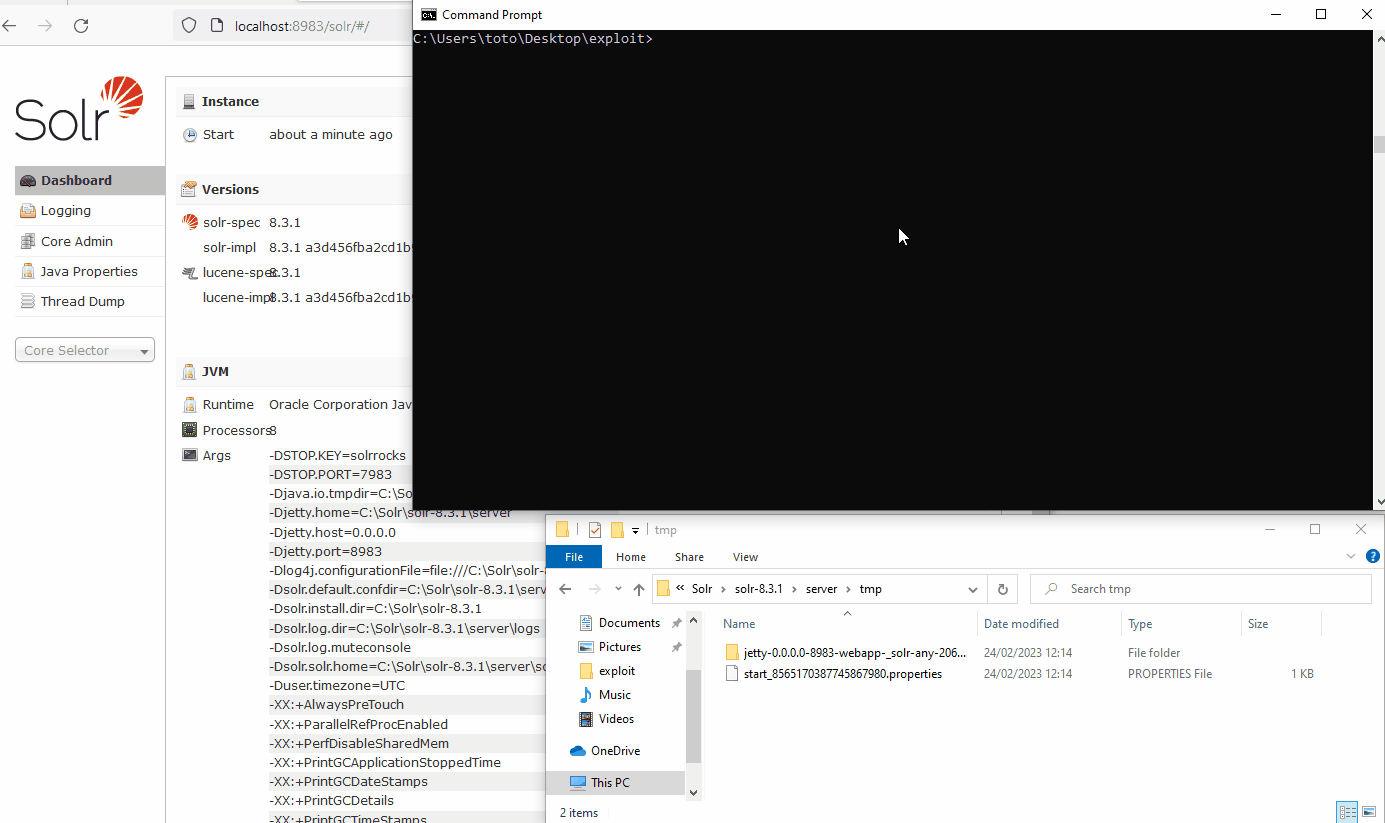Back in 2020, during an external pentest, I stumbled upon a visible Solr administration panel. With nothing else of interest, I focused on this specific application to test what was hidden underneath.
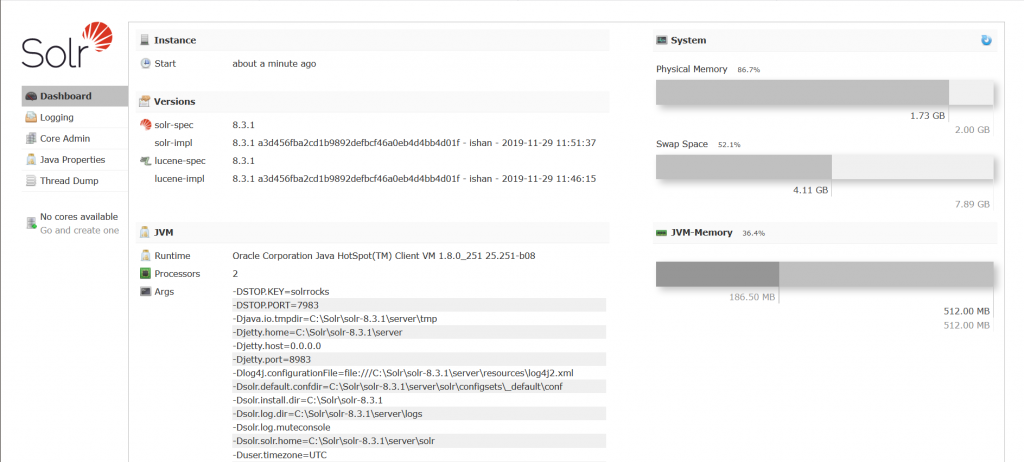
The version of Apache Solr was 8.3.1 and running on Windows. Note that this pentest was performed in 2020, way before the discovery of log4j. Under this specific version, the application should be vulnerable to CVE-2019-17558:
When text queries are handled by Solr, it is possible to add a custom Apache Velocity template that is processed with the result of the query. The issue is that this functionality can be activated without authentication. With this enabled Server-Side Template Injection, it is pretty straightforward to reach code execution using built-in feature of the Velocity language.
Solr solved this issue both in 8.3.1 and 8.4.0 by disabling the Velocity template rendering of this custom query by default. Furthermore the configuration is not modifiable from API endpoints anymore. However, version 8.3.1 is still vulnerable if some specific conditions are fulfilled, but not in this specific case. Bummer…
I then downloaded the exact same version from the Solr official website, opened the documentation, and started exploring the application in my Windows VM.
First findings
On the main page, a large amount of information about the system is revealed, such as different paths on the server, as well as the version of Solr. On the left of the following screenshot, there are no cores available.

Apache Solr is based on Cores. Every core is a separated database that can be queried and deleted from the web interface. It is also possible to create new cores, but the user has to upload configuration files manually to the server beforehand.
From the point of view of the file directory of the server, each core has a named directory inside {Base Dir}/server/solr/{Core name}. At the same level, there is also a default directory named configsets that contains examples of Solr core with their required files. I quickly found out that a dummy core can be created by using the default config files present in this directory. This creation is possible because there is no restriction to limit the path of the InstanceDir variable. Because of that, it is possible have access to at least one core and its functionality, even on a brand new Solr installation. The parameters instanceDir and dataDir can be set to any absolute or relative path, which could simplify attacks.
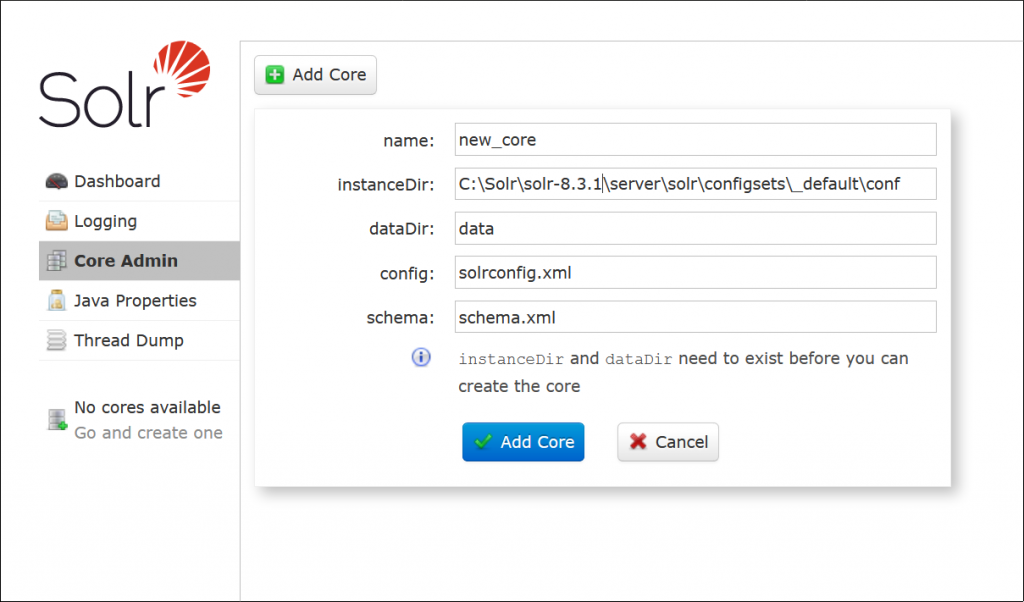
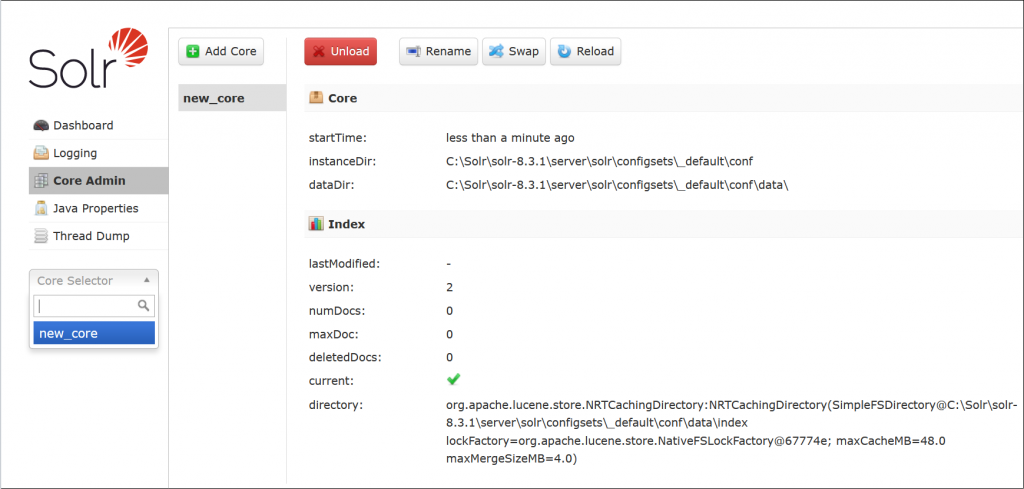
This is also a good gadget for older CVEs of Solr such as CVE-2019-17558, because most of them require that at least one core be present in order to be exploitable.
While testing for CVE-2019-17558, the documentation states that queries can be processed by Velocity or XSLT files if they exist in a specific directory. This is always a good thing to keep in mind, as arbitrary XSLT file upload would often mean arbitrary code execution on the server if they are interpreted.
Here is the summary of what was found so far:
- If discovered, an arbitrary file upload can be used to execute arbitrary code.
- A core can be created without the requirements of uploading files to the server.
- If the node creation fails, it is possible to create empty directories anywhere on the disk.
- It’s possible to discover if a file exists on the computer because of different errors returned by the interface using the core creation module.
- The majority of the parameters of Solr are vulnerable to path traversals.
File upload
In a core, it is possible to upload files and send data to be processed by the backend. Using the test files provided by Solr, the application processes them and does not save them on the server. However, when the size of a file exceeds a threshold, the server saves the full contents inside a .tmp file in the server directory {Base Dir}/server/tmp/.
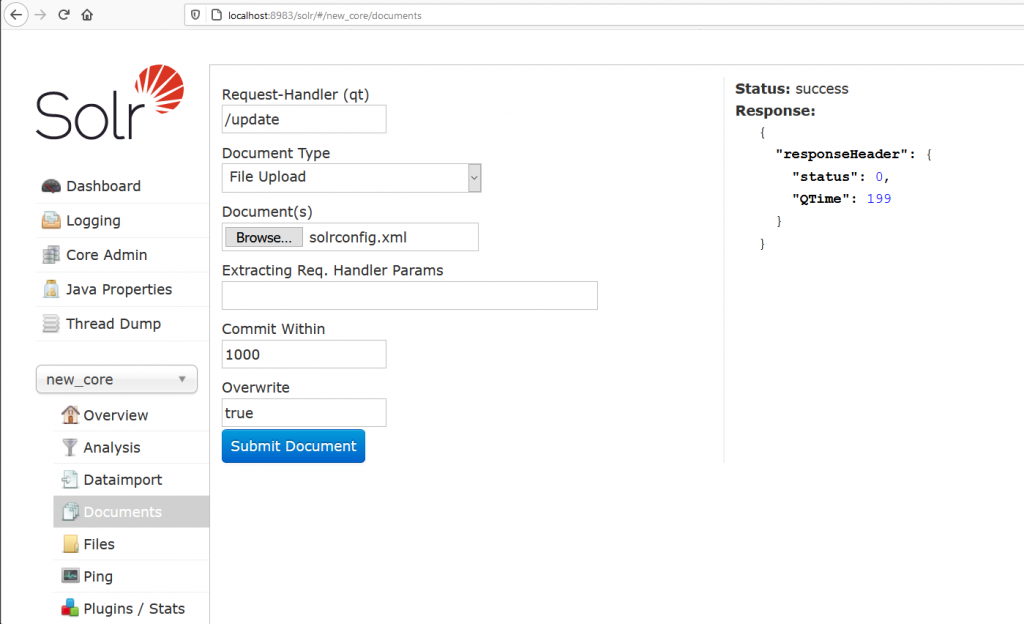
The temporary file is stored with the following name: upload_{UUID}_{iterator}.tmp.
The UUID is a constant value that is set at each reboot of the Solr server. The iterator is set to 000000000 for the first uploaded file. It is then incremented if a new .tmp file is added to the folder. In the /tmp folder, the files are deleted after 1 hour, which leaves enough time to be used for our exploitation.

I did not find another place where the UUID could be leaked, but since the server is running on Windows, the trick of Windows Short File Name can be used:
On Windows, files can have a simpler names composed of 6 alphanumeric characters followed by a tile character and a number. The names can easily be found with the windows command dir /X. As an example, the file named upload_2c59709f_b0df_400b_ad3b_668e1f02e340_00000000.tmp will have the shortname UPLOAD~1.tmp. The following files uploaded would have the shortname UPLOAD~i.tmp, with i = 2,3,4. Afterward the names become UP{4 alphanumeric hashes}~1.tmp, because of how the short file name is implemented by Windows.
Now, arbitrary files can be uploaded in the {Base Dir}/server/tmp/ directory and the name of the files are guessable. The next step is to upload an XSLT file and trigger it with a query:
http://localhost:8983/solr/new_core/select?q=:&wt=xslt&tr=../../../../../tmp/UPLOAD~1.tmp&rows=1000Error 500: [Redacted] Caused by: java.io.IOException: File C:\Solr\solr-8.3.1\server\tmp\UPLOAD~1.tmp is outside resource loader dir C:\Solr\solr-8.3.1\server\solr\configsets_default\conf; set -Dsolr.allow.unsafe.resourceloading=true to allow unsafe loadingEven if our path traversal is successful, an additional security check is present. The XSLT file must be in the same folder as the core to be considered as safe to allow execution.
Bring the Core to our file upload
The idea is straightforward. Arbitrary files can be uploaded in the /tmp directory. A core can be created at an arbitrary path if the configuration files are present. Thus, the temporary directory can be leveraged to create a core. Then, if XSLT files exist in the temporary directory, they would be considered as safe by this core.
To create a core, the application needs at least 2 files: solrconfig.xml and schema.xml. In a real core creation, the files reference other files to load such as language packs. To reduce the complexity, the 2 files were trimmed to a bare minimum.
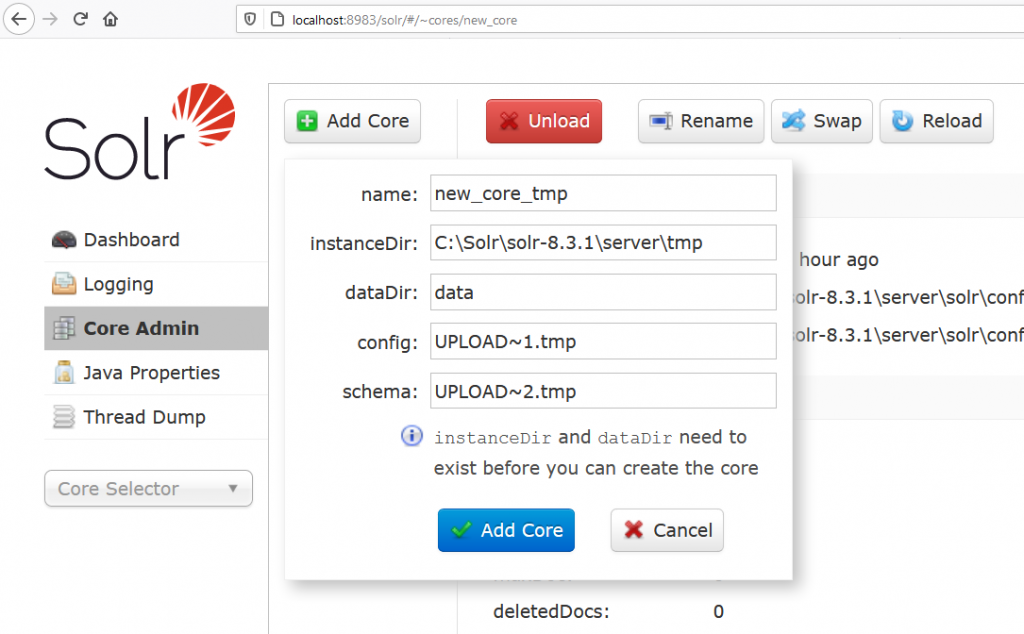
RCE from an XSLT file
After the creation of a core in the /tmp directory, an XSLT file can be uploaded and safely triggered. Gaining arbitrary command execution is pretty trivial using the payloads available in PayloadAllTheThings.
<xsl:stylesheet version="1.0" xmlns:xsl="http://www.w3.org/1999/XSL/Transform"
xmlns:fo="http://www.w3.org/1999/XSL/Format"
xmlns:dyn="http://exslt.org/dynamic"
extension-element-prefixes="dyn" xmlns:rt="http://xml.apache.org/xalan/java/java.lang.Runtime" xmlns:sys="http://xml.apache.org/xalan/java/java.lang.System" xmlns:ob="http://xml.apache.org/xalan/java/java.lang.Object">
<xsl:output media-type="text/xml" method="xml" indent="yes"/><xsl:template match='/'>
<add>
<xsl:variable name="rtobject" select="rt:getRuntime()"/>
<xsl:variable name="process" select="rt:exec($rtobject,'calc.exe')"/>
<xsl:variable name="processString" select="ob:toString($process)"/>
<xsl:value-of select="$processString"/>
</add>
</xsl:template>
[REDACTED]
</xsl:stylesheet>
<!-- comments used to make the file bigger than 20kb AAAAAAAAAAAAAA[REDACTED]AAAAAAAAA-->It will run the famous calc.exe. For the last time the XSLT is triggered from the following URL:
http://localhost:8983/solr/new_core_tmp/select?q=*:*&wt=xslt&tr=../UPLOAD~1.tmp
Note on the temporary files
Even if the short name of the uploaded files have to be guessed, this exploit is quite reliable because:
1. The temporary files are deleted every hour in the /tmp directory.
2. When the malicious core is created in the /tmp directory, it automatically removes all the other .tmp files. This is a nice feature for this exploit, because uploading the XSLT afterwards would mean that it is pretty sure to be reachable through the Windows short name UPLOAD~1.tmp.
Overview
From an exposed Solr interface it was possible to gain RCE on the server. This weakness exists until version 8.3.2 on Windows. In the newer versions, the following restrictions were implemented:
- The
.tmpfiles are not stored as plain files anymore - A new core cannot be created in the /tmp folder
- Most of the path traversals are either blocked or whitelisted
For linux, if there is a way to leak the UUID, this vulnerability won’t need the Windows short file name mechanism, thus RCE on a Unix server would be possible.
Current exploitation of Solr
- Solr had many vulnerabilities in the past that allow to find at least one reliable RCE. A good resource for their PoCs are listed in this repository: (CVEs before 2020) https://github.com/veracode-research/solr-injection
- An arbitrary file upload vulnerability was found for the Solr version before 8.8.1. Uploading an XSLT with this could lead to a similar RCE. 👉😎👉
- The famous log4shell exists in all the version of Solr before 8.11.1. So it’s far more reliable for quick wins.
- Google Dork: intitle:”Solr Admin” “Solr Query Syntax”
Disclosure timeline
13.10.2020: Vulnerability disclosed to Apache.
20.10.2020: Apache responded that it is not viewed as a security vulnerability because, parts of the exploit uses the Admin API.
21.10.2020: Asked and got permission to write a blog post about it.
2020-2023: The blog post caught covid and took a while to recover
23.02.2023: Blog post released
Note on the admin API
As far as I know, a basic installation of Solr does not use any type of security such as a password protection or account management. Improving the security is done manually by the user through the installation of additional plugins or a firewall configuration. Relying on the average user to secure the application is very risky, especially if the administrator interface is visible (and vulnerable) by default to everyone ¯\_(ツ)_/¯.
PoC
The proof of concept is available here: https://github.com/scrt/Apache-Solr-8.3.1-RCE
